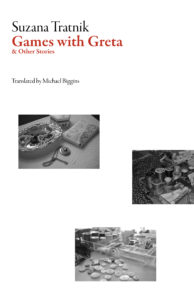 [Dalkey Archive Press; 2016]
[Dalkey Archive Press; 2016]
Tr. by Michael Biggins
Reading Suzana Tratnik’s fiction is a highly pressurized experience. Her stories are concerned with tense subjects like violence, betrayal, and systematic societal exclusion, and the prose itself reflects this tension, caught between the urge to convey the effects of cruelty as directly as possible and the understanding that such subjects require language to bend, sometimes in disorienting fashion. At her best, this combination of directness and dislocation provides intense friction; within a story — and sometimes within a paragraph —- the language pivots between precise social naturalism and passages of deep, sometimes disassociative interiority.
Tratnik’s fiction revolves around queer life in her native Slovenia, and in her latest collection, Games with Greta, the effects of the social (and sometimes physical) violence that confronts queer women in the former Yugoslavia — and the ways in which these women perceive, transfigure, and resist such violence — are scrupulously conveyed in both their exterior and interior manifestations. Throughout, Tratnik’s ability to move from cool observation to almost uncomfortable intimacy with her characters lends her portraits a remarkable level of nuance.
This conflict between exterior and interior is at its sharpest in the stories that explicitly dramatize desire. In the title story, the narrator confronts a cousin at a family gathering who has spent time in England. Tratnik’s appraisal of her family’s overwhelming need to appear cultured in the face of these “English” visitors is clear-eyed and cruelly ironic; the narrator is expected to practice her English with Greta, to show off for the visitor, to play games with her. But as the story moves along, what first seems like detachment and repulsion at the visiting girl’s snobbery towards Slovenian ways becomes a sort of reflexive measuring, a mirror through which the narrator can see her own life — and the source of her fascination with her cousin. She decides to impress Greta by slaughtering a chicken, an act of violence that will offend her repressed “English” nature:
Of blood there was actually fairly little. There was practically none in the pan, only the ax was bloody. I wiped it off on the grass as well as I could, and covered the severed half of the chicken’s head with the perforated pan… Greta was still standing in the same spot. I was afraid to meet her eyes, but her face looked calm, only a bit inquiring, as though she expected some kind of closure to enable her to make some sense of this game . . . I still didn’t dare look her in the eye — now I was embarrassed. Her cheeks were spattered with a few drops of blood. I don’t think she would’ve minded that, even if she’d known. Again I felt the desire to touch her.
The “game,” begun at the behest of the two families, starts to escalate; after the haphazard butchering is completed, the narrator tricks Greta into looking deeply into a well, and then catches her helplessly at the lip, pressing her own body into Greta’s. At this point the narrator loses the ability to distinguish divisions between herself and her cousin:
Greta seemed to start breathing only then: her chest filled with air forcefully and her stomach caved in, so that her buttocks pressed hard against my crotch. I was incapable of doing anything anymore, I just grabbed her harder, while my hands nervously slid up her belly, chest, neck. We panted in unison, united by a common terror, in an uncontrollable, unsupportable trancelike state, and I couldn’t tell whether my head was spinning or if we were really rocking forward and backward, toward the well and back to the ground . . .
The narrator’s habitual reserve is suddenly overwhelmed, blind-sided by feelings she can no longer control — a common enough occurrence for Tratnik’s narrators, who often find themselves in situations where passion overcomes their rational reservations, and where they have difficulty distinguishing between their own identity and their desire to please or harm those they love. As they change the game which society dictates, they sometimes lose track of the rules.
A similar struggle with power and confusion affects the dominant/submissive relationship between two women in another story, “Below Zero” — but whereas in the title story the majority of language is direct, naturalistic, and shaded with irony, here the language pushes past the bounds of realism to try and delineate the psychological effects of desire between two women who are conflicted about their own intimacy:
And if you took too long to slide down my body, I’d contract, grow impatient, my head would nod down to my knees and my stumps would slough off, little symbols shooting past my eyelids, and I became pleasantly strange and unfamiliarly beautiful, as though undergoing metamorphosis when I closed my eyes in delight.
The reader receives very little information about the unnamed characters in “Below Zero,” except that one of them is dead — and the story opens up several possibilities for how this death might have occurred. Did the narrator murder her lover, or is the “you” of the story a psychological division within her consciousness? Is the death itself a form of fantasy, a way to deal with the grief of losing a lover? The scene of the two lovers’ final night together blurs the distinction between the violence of sex and death:
And then came your moans. I still had my eyes shut — shut tight, not even a sliver of light got through as you came, it was all too real for either of us to have faked it, I had no real awareness what all was around me. How much of me or anyone else was there. Anatomy had been wiped out. I dried myself with your T-shirt and tossed it into the corner. You lay there, your back possibly still glistening with sweat . . . I knew I was never going to touch you again. A few days later . . . even I don’t like you that unattractive and bluish . . .
“Below Zero” is the most abstract story in the collection, and its insistence on interior at the exclusion of context raises more questions than it solves. Its themes are better understood, however, after reading the stories in the collection which explicitly reference the violence done to queer women in Slovenian society. In “Sewing the Princess,” the young narrator turns to a seamstress to help her build the dress in which she will take revenge on the boys who have brutally beaten her. The narrator’s depiction of the beating represents just how effective Tratnik’s manipulation of distance and intimacy can be when conveying the reality of trauma:
Although everything happened so fast that it was impossible to describe it all afterwards in very much detail without having to doubt the veracity of your words, and though my position under the weight of the blows, shoves, and kicks changed very quickly, I do remember the rays of the red evening sun that flooded the patches of snow on the ground in the park. And their eyes — I remember them best of all. The dark eyes of the third one . . . His eyes kept darting in excitement from his friends to my body, and his blows were so imprecise, as though he’d forgotten that you aim with your eyes, not your clenched fists. But I suspect it was precisely his clumsy, slapdash punch that, while it spared my left eyebrow, did serious damage to my eardrum. To this day my schoolmates think my hearing is bad from the attack in the park. In fact, I hear perfectly well now, though I haven’t let anyone at school know that.
The stories of young adults in collection help provide a sense of collective memory for the adult characters, and give the reader clues for why they have difficulty establishing easy intimacy. Later in “Sewing the Princess,” a seemingly well-meaning detective asks the narrator if anyone ever calls her names. “[S]ometimes I’ve been called a bitch, sometimes a heifer,” the narrator replies. “I don’t know if those count as bad names.” But the detective has other names in mind. “Has anyone ever called you a queer?” he asks. The narrator refuses to respond, but the question helps explain why she won’t identify her attackers by name, opting instead for a secret revenge of her own — one too delicious to spoil here.
Perhaps it’s the sense of this collective trauma that lends Tratnik’s voice the bitter toughness which is on display throughout, and which helps to unify the disparate formal and structural conceits she employs. This toughness is particularly effective when she turns her eye on her contemporaries in the Slovenian art scene, as in her profile of an artist and a social climber in the story “The Subway”:
At that time Ines was lesbian, but still her own person — neither a nutcase nor an addict nor a drunk — which made her want to clean everything up, so that the public and her parents wouldn’t have to think that all queers and dykes were necessarily weirdos and drug addicts . . . Then the Berlin Wall came down and the first things to get cleaned up were some lesbian and gay bars. But thank God in Ljubljana Ines wouldn’t have to deal much with that problem, because here lesbians and queers cleaned themselves up for the most part and got out of the way. After our trip together to Prague, Ines quit being lesbian. She did send me one more picture postcard from Paris, where she was doing graduate work, and then she went polysexual or whatever.
As one can tell from this passage, Tratnik is not interested in portraying Slovenia’s queer scene as a bastion of solidarity and fellow-feeling. There are many penetrating portraits in this collection, similar to the one of Ines; Tratnik’s devotion to directness and clear-eyed observation make her an appealing, if occasionally cynical, guide through the community, with its various poseurs, lifers, and fellow-travelers.
Tratnik’s structural conceits aren’t always as impressive as her observations. The stories tend to be either episodic or tightly wound around a central metaphor, and both strategies have their flaws. Some of the episodes, like the vignette “A Key to the Restroom,” which exposes the fear around public gender roles and the holes in a failing relationship, feel a little too slight to provide resonance. Others, like “Sewing the Princess,” feel contrived in their conceits. The way the girl’s work with a seamstress dovetails with a surgical scar for wounds she received at the hands of neighborhood boys seems slightly neat, as do the final few lines of “The Subway,” in which Ines’ model for a Ljubljana subway comes to stand for the whole of her life in the city: “I nodded to her from the doorway, casting a final glance at the model of the subway. Then my Ana put her arm around me. My Ana, my stations, my Ljubljana, my Europe, my geography.” Here, in searching for resonance, Tratnik settles for a surface reconciliation of so many conflicts: between the narrator and Ines, between the narrator and her lover, Ana, and between the narrator and the city of Ljubljana. In a moment, the social struggle that makes Tratnik’s stories so compelling dissipates, and a single glimpse at a model train station is simply too small an image to stand in for so many interlacing lives.
This difficulty with structure is more pronounced when Tratnik writes in the third person, which robs her of her ability to shift intimate registers at will and exposes the weakness of her plots. Without the interior element, the story of a relationship between two women who visit Amsterdam for a New Year’s trip detailed in “Trips are Cheaper Now, Too” feels aimless. So skilled at drilling deep into a narrator’s mind, Tratnik seems less able to develop her characters’ lives through actions, and her habitual distance sometimes makes it seem as if she’s having a laugh at their expense. “After they’d had sex and Vivi had cried over herself and bitched about her adverse life circumstances and finally fallen asleep, Jana started dinner . . . She decided to make a pizza — you just throw some stuff on it and pop it in the oven —she wasn’t stoned enough to overreach herself and set about making trout amandine, for instance, or some Melanesian dish.” Without the pressure of intimacy, Tratnik’s prose loses some of its exquisite tension, becoming more flat and less vivid.
In some stories, however, the structural metaphors are looser, less forced, and Tratnik achieves a kind of ruminative storytelling rhythm that is both deeply appealing and resonant. In the longer story “Letters From a Prisoner,” the narrator, reeling from a breaking with a deceitful girlfriend, finds a certain relief in letters her roommate receives from a man in prison. At first the comparison feels slightly precious; the reader thinks that these letters are meant to shed light on the narrator’s own feelings of alienation. But as the story proceeds it becomes clear that the prisoner’s words are themselves a kind of fiction, and that they reflect the narrator’s girlfriend’s inability to say anything original about love. The final result is a tricky balance between intertextual metafiction and precise social observation, in which the structural conceit frames Tratnik’s unsparing vision of contemporary courtship in ways that feel unexpected and unforced.
This more relaxed register culminates in a suite of four stories just before the end. In each other, Tratnik meets and converses with a different character struggling to create a life for herself as a lesbian as the former Yugoslavia breaks apart. These stories feel more autobiographical and conversational than the previous ones. As she describes the struggles of these women, her habitual irony softens, as if her eye has finally found something to observe which seems worthy of it: Krisa, who works at an NGO protecting sexual minorities in Fiji; Mara, who falls in love with a co-worker, only to have them scattered by the war; Manja, the housewife seeking a lover through an illicit personal ad. Here, as nowhere else in the collection, we see Tratnik’s honesty leavened with a deep sympathy for the pain of others, and her position as an ally, not only in her own community but around the world.
This post may contain affiliate links.







